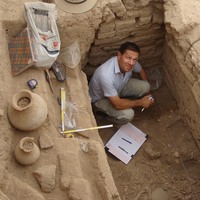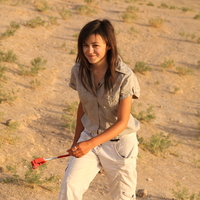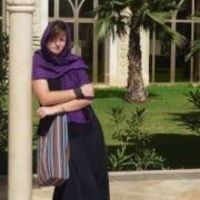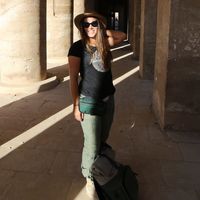
Rafal Kolinski
Phone: +48-61-8291411
Address: Faculty of Archaeology
Adam Mickiewicz University
Uniwersytetu Poznańskiego Str. 7
61-614 POZNAN, POLAND
Address: Faculty of Archaeology
Adam Mickiewicz University
Uniwersytetu Poznańskiego Str. 7
61-614 POZNAN, POLAND
less
Related Authors
Dorota Lawecka
University of Warsaw
Arthur Stefanski
University of Toronto
Michalina Dzwoniarek-Konieczna
Polish Academy of Sciences
Otto Bagi
Durham University
Aleksandra Pawlikowska-Gwiazda
University of Warsaw
Peter Pfälzner
Eberhard Karls Universität Tübingen
Łukasz Sokołowski
Kunsthistorisches Institut in Florenz / Max-Planck-Institut
InterestsView All (22)










Uploads
Books by Rafal Kolinski
Working in an area located only 40 km south of the famous Şaneder/Shanidar cave, it was natural to devote much attention to sites of this type and traces of potential prehistoric occupation which might have been preserved there. As a result, 110 caves of various size were documented during the 2015, 2016 and 2017 field seasons. The volume presents 91 of these, omitting a group of rock shelters with no sediments preserved inside. Plans, descriptions and photographs of each cave are accompanied by information on finds collected inside and on the talus below its entrance (if present). Moreover, a presence of speleothems in the caves was noted, as a potential basis for the analysis of climatic proxies. While most of the documented caves yielded traces of modern and pre-modern use, only some of the collected pottery and rock artefacts may point to their earlier occupation.
SHIK 9. KUEDISH VERSION OF ABSTRACT.
پرۆژەی سیخوڕی شوێنەواری زابی گەورەی سەرەوە (UGZAR) ڕووپێوییەکی شوێنەواریی لە کوردستانی عێراق ئەنجامدا لەسەر ڕووبەری زیاتر لە 3000 کم2، کە دەکەوێتە هەردوو کەناری ڕووباری زابی گەورە، لە باکوور و باکووری ڕۆژئاوای هەولێر. لە ماوەی شەش وەرزی مەیدانیدا، کە لە ساڵانی ٢٠١٢-٢٠١٧ ئەنجامدرا، تیمی پۆڵەندی لە زانکۆی ئادەم میکیڤیچ لە پۆزنان ٣١٣ شوێنی شوێنەواریی، ١١٠ ئەشکەوت و ٧٨ شوێنەواری میراتی دیکەیان لەوێ بەڵگەدار کرد (کڵێسا، خانەقا، مزگەوت، قەڵا، میڵ، گۆڕ و گۆڕستان و هتد .)، هەروەها چوار ڕیلیفی بەرد (سێ لە گوندک و یەکێک لە باتاس). لە کاتی کاری مەیدانیدا، نزیکەی ٢٠ هەزار شوێنەوار کە مێژووەکەیان دەگەڕێتەوە بۆ سەردەمی کۆتاییەکانی بەردینە نوێیەکان (کلتووری حەسونە) تا سەردەمی مۆدێرن (سەرەتای سەدەی بیستەم) کۆکرانەوە و بەڵگەیان لەسەر کرا.
کارکردن لە ناوچەیەک کە تەنها ٤٠ کم لە باشووری ئەشکەوتی بەناوبانگی شانەدەر/شانیدارەوە دوورە، سروشتی بوو کە گرنگییەکی زۆر بە شوێنەکانی ئەم جۆرە و شوێنەواری داگیرکردنی پێش مێژوویی ئەگەری تەرخان بکرێت کە لەوانەیە لەوێ پارێزراو بووبێت. لە ئەنجامدا 110 ئەشکەوت بە قەبارەی جیاواز لە وەرزەکانی کێڵگەیی 2015 و 2016 و 2017 بەڵگەدار کران. بەرگەکە ٩١ لەوانە خراوەتەڕوو، کۆمەڵێک پەناگەی بەردیان لابردووە کە هیچ نیشتوویەکیان لەناوەوە نەپارێزراوە. پلان و وەسف و وێنەی هەر ئەشکەوتێک لەگەڵ زانیارییەکانی ئەو دۆزراوانەدایە کە لە ناوەوە و لەسەر تالوسی خوارەوەی دەرگای چوونە ژوورەوەی کۆکراونەتەوە (ئەگەر هەبێت). سەرەڕای ئەوەش، بوونی سپێلیۆتێمەکان لە ئەشکەوتەکاندا ئاماژەی پێکرا، وەک بنەمایەکی پۆتانسێل بۆ شیکارییەکانی پرۆکسی کەشوهەوا. لە کاتێکدا زۆربەی ئەشکەوتە بەڵگەدارەکان شوێنەواری بەکارهێنانی مۆدێرن و پێش مۆدێرنیان لێکەوتەوە، بەڵام تەنها هەندێک لە کۆفە و شوێنەوارە بەردییە کۆکراوەکان ڕەنگە ئاماژە بە داگیرکردنی پێشوویان بکەن.
SHIK 9. ARABIC VERSION OF ABSTRACT.
نفذ مشروع الاستطلاع الأثري الزاب الأعلى (UGZAR) مسحاً أثرياً في كردستان العراق على مساحة تزيد عن 3000 كيلومتر مربع، تقع على ضفتي نهر الزاب الكبير، شمال وشمال غرب مدينة أربيل. خلال ستة مواسم ميدانية، أجريت في 2012-2017، قام الفريق البولندي من جامعة آدم ميكيفيتش في بوزنان بتوثيق 313 موقعًا أثريًا و110 كهفًا و78 معلمًا تراثيًا آخر (الكنائس والأديرة والمساجد والقلاع والمطاحن والمقابر والمقابر، إلخ). .) بالإضافة إلى أربعة نقوش صخرية (ثلاثة في جوندك وواحدة في باتاس). خلال العمل الميداني، تم جمع وتوثيق ما يقرب من 20.000 قطعة أثرية تعود إلى أواخر العصر الحجري الحديث (ثقافة الحسونة) إلى العصر الحديث (أوائل القرن العشرين).
أثناء العمل في منطقة تقع على بعد 40 كيلومترًا فقط جنوب كهف شنيدر/شانيدار الشهير، كان من الطبيعي تكريس الكثير من الاهتمام لمواقع من هذا النوع وآثار احتلال محتمل في عصور ما قبل التاريخ والتي ربما تم الحفاظ عليها هناك. ونتيجة لذلك، تم توثيق 110 كهفاً بأحجام مختلفة خلال المواسم الميدانية 2015 و2016 و2017. يعرض المجلد 91 منها، مع حذف مجموعة من الملاجئ الصخرية التي لا تحتوي على رواسب محفوظة بداخلها. المخططات والأوصاف والصور الفوتوغرافية لكل كهف تكون مصحوبة بمعلومات عن الاكتشافات التي تم جمعها داخل الكهف وعلى الكاحل أسفل مدخله (إن وجد). علاوة على ذلك، لوحظ وجود الكهوف في الكهوف، كأساس محتمل لتحليل الوكلاء المناخيين. في حين أن معظم الكهوف الموثقة أظهرت آثارًا للاستخدام الحديث وما قبل الحديث، إلا أن بعض المصنوعات الفخارية والصخرية التي تم جمعها قد تشير إلى احتلالها السابق.
Working in an area located only 40 km south of the famous Şaneder/Shanidar cave, it was natural to devote much attention to sites of this type and traces of potential prehistoric occupation which might have been preserved there. As a result, 110 caves of various size were documented during the 2015, 2016 and 2017 field seasons. The volume presents 91 of these, omitting a group of rock shelters with no sediments preserved inside. Plans, descriptions and photographs of each cave are accompanied by information on finds collected inside and on the talus below its entrance (if present). Moreover, a presence of speleothems in the caves was noted, as a potential basis for the analysis of climatic proxies. While most of the documented caves yielded traces of modern and pre-modern use, only some of the collected pottery and rock artefacts may point to their earlier occupation.
It contains a complete data on 38 archaeological sites located along the western border of the UGZAR work area, analysis of relevant satellite imagery and images from spy aircraft U2 mission and spy satellite CORONA program.
Papers by Rafal Kolinski
remains dating from the early 3rd millennium BC to the mid 2nd millennium BC. Recent excavations in
Sector P, on the eastern slope of the site, revealed the existence of a significant occupation of the Post-Akkadian/
Early Jazirah V period and of levels dated to the Early and Classic Khabur Ware/Old Jazirah/Middle Bronze Age
I-II periods. Cereal remains were dominated by grains and ear fragments of hulled two-rowed barley Hordeum
distichon. Less numerous were wheats represented by emmer Triticum dicoccon, einkorn T. monococcum, and
macaroni wheat T. durum. The presence of bread wheat T. aestivum and six-rowed barley Hordeum vulgare
could not be excluded. The two periods contained similar sets of cereals, but in the Post-Akkadian Period the
percentage of hulled wheat remains was higher, while in the Middle Bronze Age (particularly in its younger
phase) naked wheat slightly exceeded hulled wheats. Legumes were represented by only very few seeds of lentil
Lens culinaris and bitter vetch Vicia ervilia. Diaspores of wild plants were very abundant, particularly those
from the families of grasses and legumes. The considerable number of ear and culm fragments probably belonging
to cereals as well as numerous seeds/fruits of wild plants suggests that the plant remains originated from
fodder or animal dung or belonged to threshing waste. The presence of grass stems with nodes indicated that
cereals were reaped low on the straw; occasional use of uprooting was suggested by the occurrence of basal culm
fragments with traces of rootlets.
Working in an area located only 40 km south of the famous Şaneder/Shanidar cave, it was natural to devote much attention to sites of this type and traces of potential prehistoric occupation which might have been preserved there. As a result, 110 caves of various size were documented during the 2015, 2016 and 2017 field seasons. The volume presents 91 of these, omitting a group of rock shelters with no sediments preserved inside. Plans, descriptions and photographs of each cave are accompanied by information on finds collected inside and on the talus below its entrance (if present). Moreover, a presence of speleothems in the caves was noted, as a potential basis for the analysis of climatic proxies. While most of the documented caves yielded traces of modern and pre-modern use, only some of the collected pottery and rock artefacts may point to their earlier occupation.
SHIK 9. KUEDISH VERSION OF ABSTRACT.
پرۆژەی سیخوڕی شوێنەواری زابی گەورەی سەرەوە (UGZAR) ڕووپێوییەکی شوێنەواریی لە کوردستانی عێراق ئەنجامدا لەسەر ڕووبەری زیاتر لە 3000 کم2، کە دەکەوێتە هەردوو کەناری ڕووباری زابی گەورە، لە باکوور و باکووری ڕۆژئاوای هەولێر. لە ماوەی شەش وەرزی مەیدانیدا، کە لە ساڵانی ٢٠١٢-٢٠١٧ ئەنجامدرا، تیمی پۆڵەندی لە زانکۆی ئادەم میکیڤیچ لە پۆزنان ٣١٣ شوێنی شوێنەواریی، ١١٠ ئەشکەوت و ٧٨ شوێنەواری میراتی دیکەیان لەوێ بەڵگەدار کرد (کڵێسا، خانەقا، مزگەوت، قەڵا، میڵ، گۆڕ و گۆڕستان و هتد .)، هەروەها چوار ڕیلیفی بەرد (سێ لە گوندک و یەکێک لە باتاس). لە کاتی کاری مەیدانیدا، نزیکەی ٢٠ هەزار شوێنەوار کە مێژووەکەیان دەگەڕێتەوە بۆ سەردەمی کۆتاییەکانی بەردینە نوێیەکان (کلتووری حەسونە) تا سەردەمی مۆدێرن (سەرەتای سەدەی بیستەم) کۆکرانەوە و بەڵگەیان لەسەر کرا.
کارکردن لە ناوچەیەک کە تەنها ٤٠ کم لە باشووری ئەشکەوتی بەناوبانگی شانەدەر/شانیدارەوە دوورە، سروشتی بوو کە گرنگییەکی زۆر بە شوێنەکانی ئەم جۆرە و شوێنەواری داگیرکردنی پێش مێژوویی ئەگەری تەرخان بکرێت کە لەوانەیە لەوێ پارێزراو بووبێت. لە ئەنجامدا 110 ئەشکەوت بە قەبارەی جیاواز لە وەرزەکانی کێڵگەیی 2015 و 2016 و 2017 بەڵگەدار کران. بەرگەکە ٩١ لەوانە خراوەتەڕوو، کۆمەڵێک پەناگەی بەردیان لابردووە کە هیچ نیشتوویەکیان لەناوەوە نەپارێزراوە. پلان و وەسف و وێنەی هەر ئەشکەوتێک لەگەڵ زانیارییەکانی ئەو دۆزراوانەدایە کە لە ناوەوە و لەسەر تالوسی خوارەوەی دەرگای چوونە ژوورەوەی کۆکراونەتەوە (ئەگەر هەبێت). سەرەڕای ئەوەش، بوونی سپێلیۆتێمەکان لە ئەشکەوتەکاندا ئاماژەی پێکرا، وەک بنەمایەکی پۆتانسێل بۆ شیکارییەکانی پرۆکسی کەشوهەوا. لە کاتێکدا زۆربەی ئەشکەوتە بەڵگەدارەکان شوێنەواری بەکارهێنانی مۆدێرن و پێش مۆدێرنیان لێکەوتەوە، بەڵام تەنها هەندێک لە کۆفە و شوێنەوارە بەردییە کۆکراوەکان ڕەنگە ئاماژە بە داگیرکردنی پێشوویان بکەن.
SHIK 9. ARABIC VERSION OF ABSTRACT.
نفذ مشروع الاستطلاع الأثري الزاب الأعلى (UGZAR) مسحاً أثرياً في كردستان العراق على مساحة تزيد عن 3000 كيلومتر مربع، تقع على ضفتي نهر الزاب الكبير، شمال وشمال غرب مدينة أربيل. خلال ستة مواسم ميدانية، أجريت في 2012-2017، قام الفريق البولندي من جامعة آدم ميكيفيتش في بوزنان بتوثيق 313 موقعًا أثريًا و110 كهفًا و78 معلمًا تراثيًا آخر (الكنائس والأديرة والمساجد والقلاع والمطاحن والمقابر والمقابر، إلخ). .) بالإضافة إلى أربعة نقوش صخرية (ثلاثة في جوندك وواحدة في باتاس). خلال العمل الميداني، تم جمع وتوثيق ما يقرب من 20.000 قطعة أثرية تعود إلى أواخر العصر الحجري الحديث (ثقافة الحسونة) إلى العصر الحديث (أوائل القرن العشرين).
أثناء العمل في منطقة تقع على بعد 40 كيلومترًا فقط جنوب كهف شنيدر/شانيدار الشهير، كان من الطبيعي تكريس الكثير من الاهتمام لمواقع من هذا النوع وآثار احتلال محتمل في عصور ما قبل التاريخ والتي ربما تم الحفاظ عليها هناك. ونتيجة لذلك، تم توثيق 110 كهفاً بأحجام مختلفة خلال المواسم الميدانية 2015 و2016 و2017. يعرض المجلد 91 منها، مع حذف مجموعة من الملاجئ الصخرية التي لا تحتوي على رواسب محفوظة بداخلها. المخططات والأوصاف والصور الفوتوغرافية لكل كهف تكون مصحوبة بمعلومات عن الاكتشافات التي تم جمعها داخل الكهف وعلى الكاحل أسفل مدخله (إن وجد). علاوة على ذلك، لوحظ وجود الكهوف في الكهوف، كأساس محتمل لتحليل الوكلاء المناخيين. في حين أن معظم الكهوف الموثقة أظهرت آثارًا للاستخدام الحديث وما قبل الحديث، إلا أن بعض المصنوعات الفخارية والصخرية التي تم جمعها قد تشير إلى احتلالها السابق.
Working in an area located only 40 km south of the famous Şaneder/Shanidar cave, it was natural to devote much attention to sites of this type and traces of potential prehistoric occupation which might have been preserved there. As a result, 110 caves of various size were documented during the 2015, 2016 and 2017 field seasons. The volume presents 91 of these, omitting a group of rock shelters with no sediments preserved inside. Plans, descriptions and photographs of each cave are accompanied by information on finds collected inside and on the talus below its entrance (if present). Moreover, a presence of speleothems in the caves was noted, as a potential basis for the analysis of climatic proxies. While most of the documented caves yielded traces of modern and pre-modern use, only some of the collected pottery and rock artefacts may point to their earlier occupation.
It contains a complete data on 38 archaeological sites located along the western border of the UGZAR work area, analysis of relevant satellite imagery and images from spy aircraft U2 mission and spy satellite CORONA program.
remains dating from the early 3rd millennium BC to the mid 2nd millennium BC. Recent excavations in
Sector P, on the eastern slope of the site, revealed the existence of a significant occupation of the Post-Akkadian/
Early Jazirah V period and of levels dated to the Early and Classic Khabur Ware/Old Jazirah/Middle Bronze Age
I-II periods. Cereal remains were dominated by grains and ear fragments of hulled two-rowed barley Hordeum
distichon. Less numerous were wheats represented by emmer Triticum dicoccon, einkorn T. monococcum, and
macaroni wheat T. durum. The presence of bread wheat T. aestivum and six-rowed barley Hordeum vulgare
could not be excluded. The two periods contained similar sets of cereals, but in the Post-Akkadian Period the
percentage of hulled wheat remains was higher, while in the Middle Bronze Age (particularly in its younger
phase) naked wheat slightly exceeded hulled wheats. Legumes were represented by only very few seeds of lentil
Lens culinaris and bitter vetch Vicia ervilia. Diaspores of wild plants were very abundant, particularly those
from the families of grasses and legumes. The considerable number of ear and culm fragments probably belonging
to cereals as well as numerous seeds/fruits of wild plants suggests that the plant remains originated from
fodder or animal dung or belonged to threshing waste. The presence of grass stems with nodes indicated that
cereals were reaped low on the straw; occasional use of uprooting was suggested by the occurrence of basal culm
fragments with traces of rootlets.